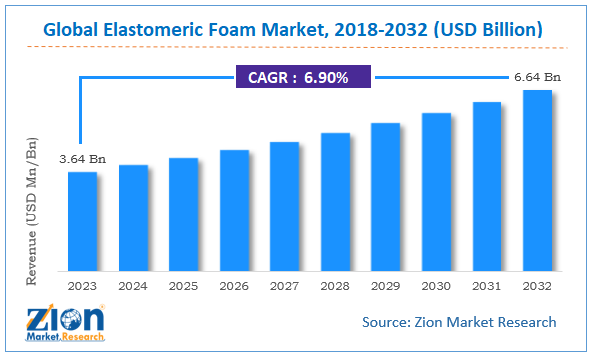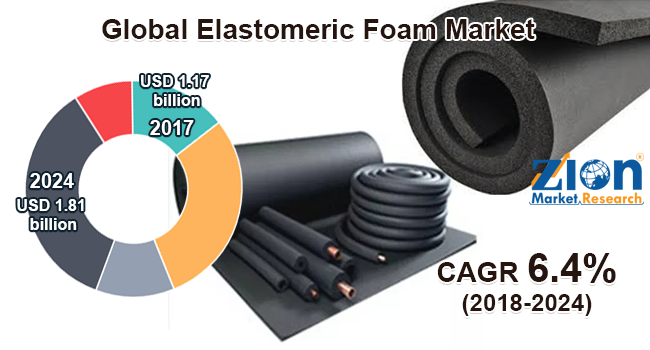Elastomeric Foam Market Size, Share & Growth Report 2032

Elastomeric Foam Market by Type (Natural Rubber/Latex and Synthetic Rubber (Nitrile Butadiene Rubber (NBR), Ethylene Propylene Diamine Monomer (EPDM), Chloroprene (CR), and Others) and by End-User Industry (HVAC, Automotive, Electrical & Electronics, Healthcare, and Others): Global Industry Perspective, Comprehensive Analysis, and Forecast, 2024 - 2032
| Market Size in 2023 | Market Forecast in 2032 | CAGR (in %) | Base Year |
|---|---|---|---|
| USD 3.64 Billion | USD 6.64 Billion | 6.90% | 2023 |
Elastomeric Foam Market: Industry Perspective
The global elastomeric foam market size was worth around USD 3.64 billion in 2023 and is predicted to grow to around USD 6.64 billion by 2032 with a compound annual growth rate (CAGR) of roughly 6.90% between 2024 and 2032.
An elastomer is a polymer with excellent elasticity and viscosity. Elastomeric foam has superior properties and is most suitable for insulation material. Elastomeric foam is used in a broad range of applications, such as for insulation materials in HVAC. These foams are widely used across industries like automotive, healthcare, and electrical and electronics, among others.
Elastomeric Foam Market: Growth Dynamics
Elastomeric foam market is projected to grow at the fastest rate with an increased demand for insulation materials. Over the last few years, there has been a rise in the overall demand for elastomeric foam due to increasing awareness regarding indoor air quality (IAQ). Elastomeric foam does not contain fibers or formaldehyde and has very low volatile organic compounds or VOCs, which have found wide acceptance among the indoor air quality advocates. Considering all these factors, it is likely that the demand for elastomeric foam will increase and have a positive impact on the overall market growth. In addition, it is the rapid industrialization in emerging countries, such as Mexico, Brazil, India, China, and Indonesia, that is propelling the demand for elastomeric foam market. These foams are widely used in the automotive industry in seat covers and designing further boosting the market growth. But, the fluctuating prices of elastomeric foam might hinder the market growth in the future. However, improvements in the technologies of elastomeric foam are expected to drive the demand for insulation materials, thereby, creating lucrative growth opportunities for elastomeric foam market in the upcoming years.
The report covers a forecast and an analysis of the elastomeric foam market on a global, and regional level. The study provides historical information for 2018 to 2022 with a forecast from 2024 to 2032 based on both volume (Kilotons) and revenue (USD Billion). The complete study covers the key drivers and restraints of the elastomeric foam market. It also provides the impact of the market within the forecast period. Furthermore, the study also includes the opportunities accessible within the elastomeric foam market on a global level.
In order to offer the users of this report a comprehensive read on the elastomeric foam market, we have enclosed a detailed value chain analysis. To know the competitive landscape within the market, an analysis of Porter’s Five Forces Model for the elastomeric foam market has additionally been enclosed within the study. The study includes a market attractiveness analysis, where all segments are benchmarked to support their market size, rate, and general attractiveness.
The study also includes the market share of the key participants operating in the elastomeric foam market across the globe. Besides, the report covered strategic development together with acquisitions & mergers, agreements, partnerships, collaborations, and joint ventures, and regional growth of key players within the market on a regional basis.
Elastomeric Foam Market: Segmentation Analysis
Elastomeric foam market is segmented based on the type and end-user industry. By type, the elastomeric foam market is bifurcated into synthetic rubber and natural rubber/latex. The synthetic rubber segment is further divided into ethylene propylene diamine monomer (EPDM), nitrile butadiene rubber (NBR), and chloroprene (CR), and others. Nitrile butadiene rubber is anticipated to dominate during the upcoming years, as it is extensively used in several end-use industries and is less expensive as compared to other synthetic rubbers. By end-user industry, the global elastomeric foam market includes HVAC, automotive, electrical and electronics, healthcare, and others. Increasing preference for HVAC systems in several industries across the globe is likely to enhance the elastomeric foam market growth. Rising focus on the construction of energy-efficient buildings is further projected to surge the demand for elastomeric foams.
Elastomeric Foam Market: Report Scope
| Report Attributes | Report Details |
|---|---|
| Report Name | Elastomeric Foam Market |
| Market Size in 2023 | USD 3.64 Billion |
| Market Forecast in 2032 | USD 6.64 Billion |
| Growth Rate | CAGR of 6.90% |
| Number of Pages | 230 |
| Key Companies Covered | Armacell, Hira Industries, Zotefoams plc, L'ISOLANTE K-FLEX, Kaimann, Huamei Energy-saving Technology Group, Jinan Retek Industries, Aeroflex USA, NMC SA, and others. |
| Segments Covered | By Type, By End-User, and By Region |
| Regions Covered | North America, Europe, Asia Pacific (APAC), Latin America, The Middle East and Africa (MEA) |
| Base Year | 2023 |
| Historical Year | 2018 to 2022 |
| Forecast Year | 2024 - 2032 |
| Customization Scope | Avail customized purchase options to meet your exact research needs. Request For Customization |
The geographic analysis of the elastomeric foam market includes North America, Europe, Asia Pacific, Latin America, and the Middle East and Africa. In 2023, Asia Pacific was the leading regional market for the elastomeric foam and is likely to continue its dominance in the future. The growing construction industry is projected to drive the elastomeric foam market growth within the region. Additionally, increasing demand for elastomeric foam from several industries, such as automotive, electrical and electronics, and HVAC, is also anticipated to fuel the elastomeric foam market growth in the near future.
Elastomeric Foam Market: Competitive Analysis
The global elastomeric foam market is dominated by players like:
- Armacell
- Hira Industries
- Zotefoams plc
- L'ISOLANTE K-FLEX
- Kaimann
- Huamei Energy-saving Technology Group
- Jinan Retek Industries
- Aeroflex USA
- NMC SA
The report segments the global elastomeric foam market as follows:
Global Elastomeric Foam Market: Type Analysis
- Natural Rubber/Latex
- Synthetic Rubber
- Nitrile Butadiene Rubber (NBR)
- Ethylene Propylene Diamine Monomer (EPDM)
- Chloroprene (CR)
- Others
Global Elastomeric Foam Market: End-User Analysis
- HVAC
- Automotive
- Electrical and Electronics
- Healthcare
- Others
Global Elastomeric Foam Market: Regional Analysis
- North America
- The U.S.
- Europe
- UK
- France
- Germany
- Asia Pacific
- China
- Japan
- India
- Latin America
- Brazil
- The Middle East and Africa
Table Of Content
Methodology
FrequentlyAsked Questions
Elastomeric foam insulation is a synthetic rubber material with a closed-cell structure that comes in pre-made tubes, sheets, or rolls. It is widely utilized in various industries including HVAC, automotive, electrical and electronics, and healthcare.
According to a study, the global elastomeric foam market size was worth around USD 3.64 billion in 2023 and is expected to reach USD 6.64 billion by 2032.
The global elastomeric foam market is expected to grow at a CAGR of 6.90% during the forecast period.
Asia Pacific is expected to dominate the elastomeric foam market over the forecast period.
Leading players in the global elastomeric foam market include Armacell, Hira Industries, Zotefoams plc, L'ISOLANTE K-FLEX, Kaimann, Huamei Energy-saving Technology Group, Jinan Retek Industries, Aeroflex USA, and NMC SA, among others.
The elastomeric foam market report covers the geographical market along with a comprehensive competitive landscape analysis. It also includes cash flow analysis, profit ratio analysis, market basket analysis, market attractiveness analysis, sentiment analysis, PESTLE analysis, trend analysis, SWOT analysis, trade area analysis, demand & supply analysis, Porter’s five forces analysis, and value chain analysis.
RelatedNews
HappyClients
Zion Market Research
Tel: +1 (302) 444-0166
USA/Canada Toll Free No.+1 (855) 465-4651
3rd Floor,
Mrunal Paradise, Opp Maharaja Hotel,
Pimple Gurav, Pune 411061,
Maharashtra, India
Phone No +91 7768 006 007, +91 7768 006 008
US OFFICE NO +1 (302) 444-0166
US/CAN TOLL FREE +1 (855) 465-4651
Email: sales@zionmarketresearch.com
We have secured system to process your transaction.
Our support available to help you 24 hours a day, five days a week.
Monday - Friday: 9AM - 6PM
Saturday - Sunday: Closed






